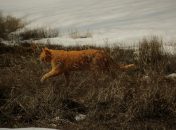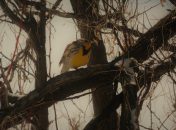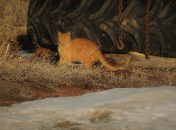It’s that time of year again! Calves are dropping as we speak. Most ranchers in our area are into the heart of calving season by now. I thought it would be an appropriate time to share a little bit of what “calving season” actually entails with those of you who are unfamiliar.
Calving season is different from any other “season” on the ranch. One of the biggest changes in responsibilities that it brings is the herd checks that must occur around the clock. Unfortunately, cows don’t just decide to sleep during the night and have their babies during the day. What a bummer! 😉
There are many factors that determine how often somebody needs to check the herd, including weather, age of cows, etc. During our coldest weather, every two hours through the night has been pretty standard at our ranch this year. Dean and the boss have split up the night checks. At 11:00 pm and 3:00 am Dean gets up and heads over to the corral with his flashlight to get a good look at each cow.
In the event that a calf was born, there is a sled which you roll the calf into and drag to the barn, ideally with the mother following close behind. This allows you to put the two of them into their own stall to bond, away from any other cows and calves who might be inside for the night.
Sometimes you notice a cow who just looks uncomfortable; she may be pacing or getting up and lying back down repetitively. She might also be “kinking” her tail. When cows are in labor they tend to have a “wave” in their lifted tails, but you have to be sure to not confuse this with when they are just raising their tails to relieve themselves. The next thing you could look for would be dilation. It takes a little while to train your eye to what normal looks like versus what a dilated cow looks like, but it could give you a clue that this cow is in the beginning stages of labor.
You might also find a cow who has a “balloon” under her tail created by the birthing sac. This is a cow midway through labor. The cow’s water may or may not have broken at this point, but usually it doesn’t take long, if everything is in good position, for you to catch a glimpse of the little front hooves of the calf starting to come out.
I have found cows at this “balloon” stage, pushed them into the barn so they could have the calf in a dry location, and half an hour later the whole process was over. Soaking wet baby quivering in the sawdust while mama cow uses her sandpaper tongue to lick the birth sack off the calf and get it nice and dry. It’s amazing how fast the birthing process can be!
Weather is a HUGE factor in the frequency of checks and the extent of post-birthing precautions. Even if it is only 20 degrees outside you can usually figure a calf will be able to be born and dry off quickly enough (if it’s mother is licking it off) that it’ll warm up and be a healthy little tyke. BUT if it’s 20 degrees with 20 mph wind gusts, it’s a different story. Thus, being on top of the outdoor conditions is a huge part of keeping calves alive and well.
The process of taking newborn calves as well as cows in labor into a barn, which I described above, usually only happens during the most severe winter conditions. During the more mild parts of winter, most ranchers successfully calve out their cows in the open field. The biggest factor in a calf getting off to a healthy start is whether or not it gets dried off and warmed up fast enough. A calf that is chilled down won’t have the strength to get on its feet and start nursing right away.
Just like in humans, the milk that a mama cow produces leading up to birth contains something called colostrum, which is crucial to the calf’s health. Since a calf does not have its own antibodies at birth, colostrum contains these necessary antibodies to protect it from infectious diseases.
So as you can see, after birth, the priorities are getting the calf dried off, warmed up, on its feet, and nursing from its mother’s supply of colostrum. When all these have taken place, you’ve got a calf who is off to a healthy start!
Unfortunately, sometimes things don’t go so smoothly. Calves can be backwards inside the womb and need pulled in order to to survive; twins can be born and the mother may not realize both calves are hers… abandoning one; or a calf could be born into a snow bank or puddle chilling it down even faster, making it unlikely to survive. Calves can even be lost if the birth sack is still over their nose when they are born, suffocating them. You can see why frequent checks are so important.
Periodically, there will be a calf who can’t seem to figure out how to nurse. Normally, its the slightly crippled or weaker calves who need help learning how. Usually after nursing once or twice on their own, they have gained strength and pretty much figured it out, but there was one calf this year who took days to get the strength up to nurse on its own. In these cases it takes a lot of patience (and back strength) to help support the calf, get it’s mouth on the mother’s teat and keep supporting and coaxing it while it tries to nurse.

Dean helping a little bull calf figure out how to nurse. This particular momma cow was extremely gentle and calm allowing Dean to do this without putting her in the head gate.
Another one of the daily tasks during calving season is getting the new calves tagged. This is how you know which calf belongs to which mother. When it’s really cold out and all the newborn calves are inside the barn, this is a pretty simple task. You go from stall to stall (while the mother’s are out eating in the corral) putting the correct tags in each calve’s ear, recording in the calving book the date born, etc. and making sure you get iodine in their navel to prevent any infection from starting.
However, when the weather is more on the mild side and the cows are being allowed to calve out in the field, it makes it a slightly more involved process. First you must locate and catch the calf. If done in the first day, this shouldn’t be a problem, but if it gets put off any more than a few days you might have a bit of trouble catching up to it! 🙂 By laying the calf down on it’s side and keeping a really good hold of it or better yet tying three legs together with a piggin’ string, you keep it from getting away from you. Then you can go about the same process as you would in the barn.
Except there is one more element to tagging in the field… the momma cow! You must accomplish the process described above without taking your eyes off of the mother because in most cases, I can guarantee you she won’t be taking her eyes off of you!
Some mother’s show their concern with low moo’s while standing by watching closely.
Other mommas don’t take so kindly to you tying up their babies and sitting on them to hold them still. 😉 Let’s just say my husband has had his shoulder re-dislocated in the past by an angry (or should I say anxious) momma cow when he was tagging her calf. He only took his eyes off of her for a second, but that was all it took. Lesson learned!
One other thing I want to tell you about is the process of grafting a calf. Earlier I briefly mentioned the scenario of a cow having twins, and not claiming them both. In situations like these, usually the easiest and best solution is to take a cow who has recently lost her calf (if you have one) and graft the twin onto her. This process doesn’t usually take more than several days, but each cow is different.
The key to this process is getting the cow to allow the calf to nurse. Many cows will kick a calf away if they know it’s not theirs, but usually, if you can get the calf to drink the cow’s milk for a couple days, the calf will start smelling familiar to the cow. Scent is how momma cows know who their baby is, so once this happens, she will start acting motherly toward it like she did with her first calf.
So you might be wondering how you make a 1,000+ lb. cow nurse a calf it doesn’t want to nurse. There are a variety of different approaches, but usually they all start with getting the cow in a head gate so it can’t move away from the calf. Sometimes simply catching the mother in this fashion is enough and she will stand still, but other times she will persistently kick the calf away.

Cow in head gate while graft calf is nursing. I am quietly standing by to make sure she behaves and doesn’t kick the calf.
Then you are forced to take further steps which could include sedating her, tying one of her hind legs back so that she can’t kick with it, or simply hobbling her hind legs. Some cows who don’t take to a calf quite as fast, can be hobbled and put in a small corral or pen with the calf for several days until they are claiming the calf as their own.
I hope this has given you a little glimpse into what rancher’s mean when they say “calving season” has begun. Granted, this is only a summary of several aspects of calving. There are always endless jobs to be done, and always new things to learn.
Since moving out here to Montana less than two years ago, I have learned a lot, BUT the store of knowledge I have tucked away is minuscule compared to what there still is to be learned. I strive to always keep an open mind and open eyes to learn everything I can.
When God gave humans dominion over the animals way back at the beginning, He was giving us humans a great responsibility. I believe that ranchers are some of the people that understand that the most as their living is made directly from the livestock under their care.
–Amanda










2 Comments
I love the pictures! You are such a good story teller!
Thanks, Hillary! I love the feedback! 😉 I’m really glad you are enjoying the pics! <3